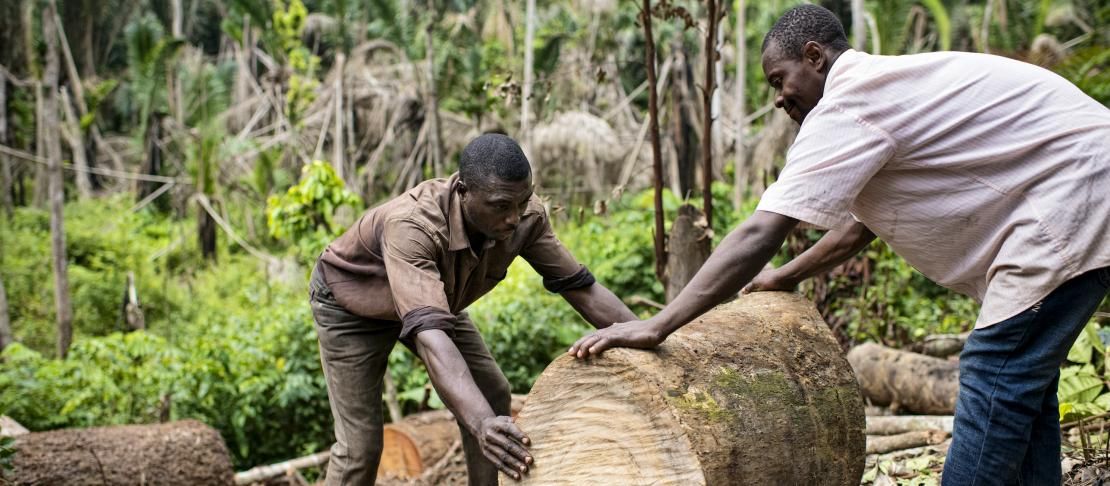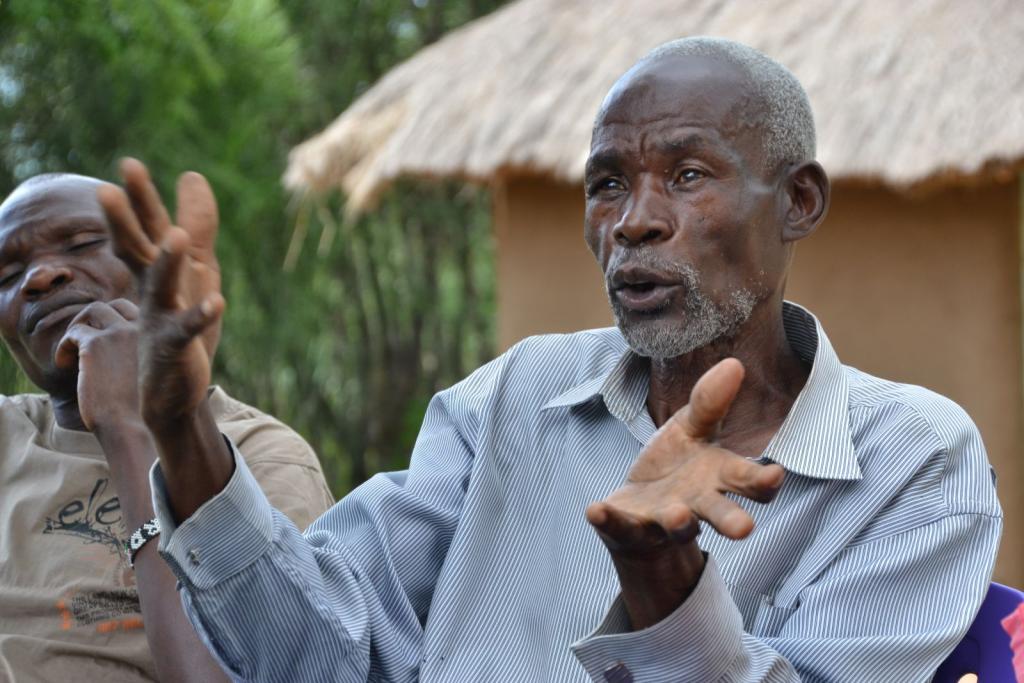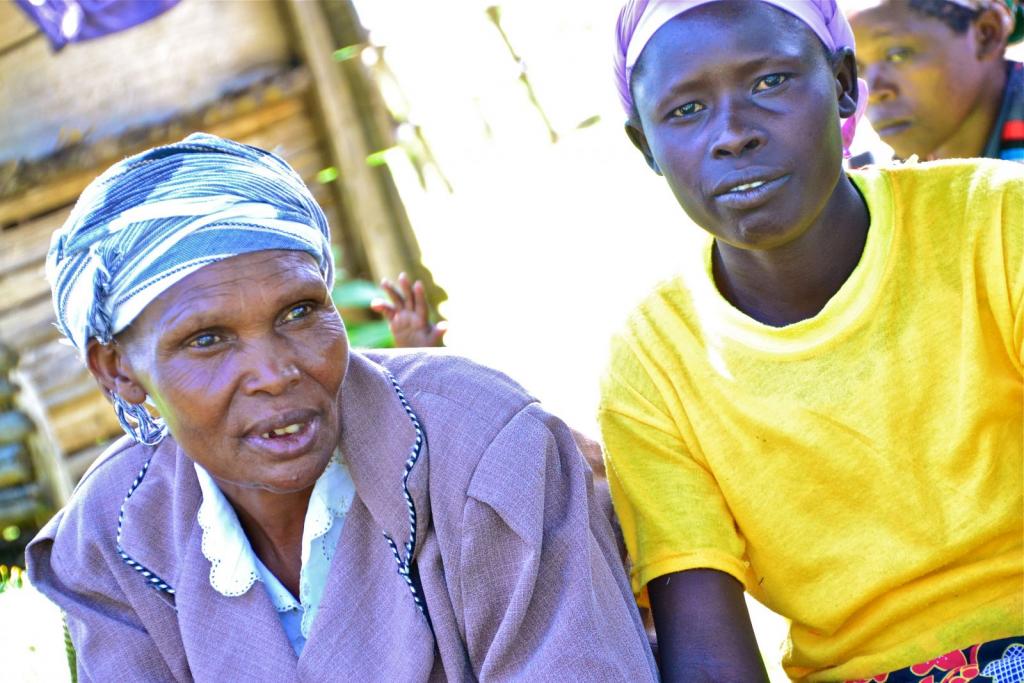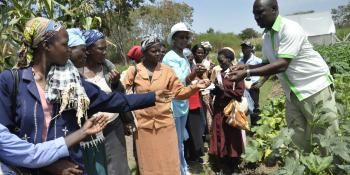Sacrificing goats and cutting down trees. A tale of climate change causes and communication

Discussion on why it is important to widely disseminate correct, useful and appropriate climate information to smallholder farmers.
“It is because we are not sacrificing animals anymore, that is why the weather is changing,” the women of Tabete village in Western Kenya explain. “That, and because our trees are being cut down.”
The group of women had joined us to talk about changes in the climate, such as rainfall, crops and livestock, during the past 10 years. Exactly how all the visible climatic changes and their own activities were linked they couldn't tell us, but they were sure that they must be connected somehow.

men talking about recent changes in the climate. photo: C.Schubert (CCAFS)
So why are we, the CGIAR Research Program on Climate Change, Agriculture and Food Security (CCAFS) gender team, high up in the hills in Western Kenya talking to men and women about sacrificing animals and changing rainfall patterns?
This session is part of an upcoming participatory action research guide which aims to support researchers and development practitioners wanting to capture gender and social differences in rural communities. The guide is now being put through the test in Western Kenya and Ghana by CARE and CCAFS and will be released later this year.
The Gender and Inclusion Toolbox will be released later this year.
Led by CCAFS, it is the product of multiple partners including Worldagroforestry Centre (ICRAF) and CARE. It builds on the previous gender research manual released in 2012 by the Food and Agriculture Organization of the United Nations (FAO) and CCAFS.
The aim for this particular participatory session is to pick up on how men and women respectively perceive changes in the climate, who in the household decides on adopting new agricultural practices, and what farmers are doing to adapt.
Both groups mentioned environmental degradation, pollution, and religious reasons as potential causes for climate change.
Climate change is non-reversable and non-negotiable
Both men and women seemed to have similar thoughts on why the weather was changing, which was interesting.
The main problem with the mentioned climate-causes is that they imply that, if farmers start sacrificing goats again or plant more trees, the weather will go back to normal. Which is, as we know, not the case.
This is why, getting accurate, understandable information about climate change in local languages is crucial. Not only that, but engaging in discussions and communicating about climate change in various ways through known mediums are also needed - from local to national level.
Fully understanding climate change and its implications will require two-way communications and not only information dissemination.
It is not until climate change is properly explained and understood that farmers will realise that the changes they are seeing are here to stay, and that they will need to adapt for the long-term.
Unfortunately, we do however know that right now, rural farmers are not the ones receiving understandable explanations to why the weather is becoming hotter and drier.
One can understand that thoughts about failing to sacrifice goats and cows might be one plausible reason to why the rains are failing once again. They are trying to make sense of a world that is no longer making sense to anyone.
View all the photos from the group meetings: Discussing changes in the climate with men and women farmers in Kenya.

The women talking about how the rain patterns have changed in their area. it is now unpredictable and insufficient.
Photo: C. Schubert (CCAFS)
Getting understandable climate information out to farmers
To try and address this knowledge gap and to encourage farmers to try and test new farming practices that might be better suited for a variable climate, our theme Linking Knowledge with Action is collaborating with Shamba Shape Up, a farm-make over program in Kenya.
Shamba Shape Up helps farmers improve their agriculture production while explaining what climate change is and how farmers can adapt to it.
We are providing climate and agriculture information that is fed into the program. The goal for us is to reach farmers with climate information that makes sense to them and climate-smart farming techniques they can implement.
The team is also exploring how to use new and multi-scale communications platforms, including radio and video, to turn research and information into action on the ground, not just among a few farmers but thousands and even millions.
The work with Shamba Shape Up (SSU) is reaching more than 12 million farmers each week as they broadcast programs every Saturday and Sunday, in both English and Kiswahili, in a number of East African countries including Kenya, Uganda, Ethiopia and Tanzania.
In East Africa however, not everyone has a TV. That is why we are looking into expanding the work of SSU by engaging with innovative local partners. One of these partners is Groots Kenya.
Groots is a network of women self-help groups and community organizations in the country. They will show they program in several of the groups they are working with, further expanding the target audience and people who are reached by information about agriculture and climate change.
Watch a CCAFS-supported episode of Shamba Shape Up where farmers Cecilia and Philip who need assistance on how to make a farming plan, grow sorghum, planting trees and rain harvesting.
Cecilia Schubert works as a Communications Officer for CCAFS Theme 4, including Linking Knowledge to Action. She joined the testing of the upcoming participatory action research manual on gender-related and social inclusion issues. The guide will be released later this year.
The session mentioned in the story might come to change depending on the results from testing it in Western Kenya and Ghana.



